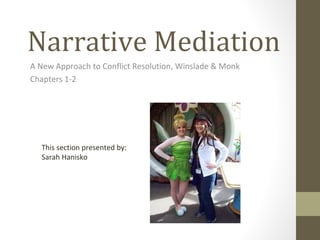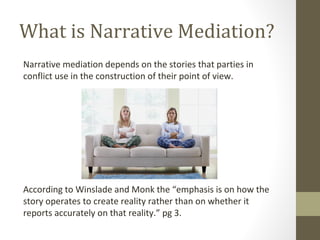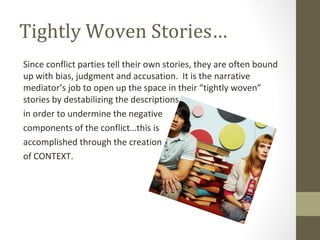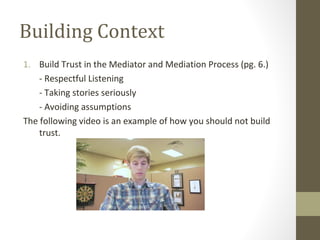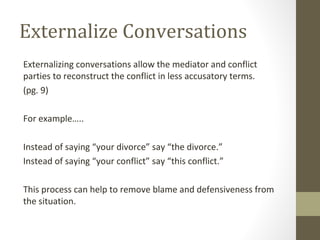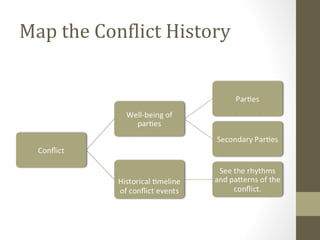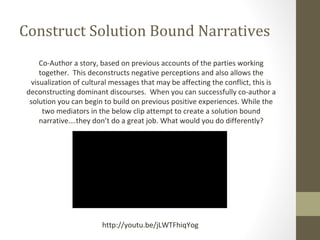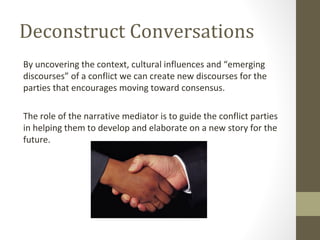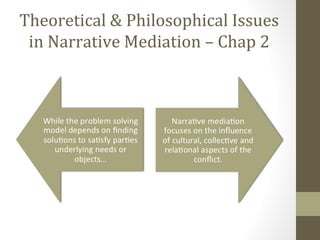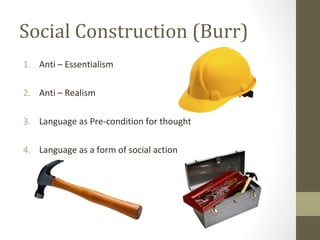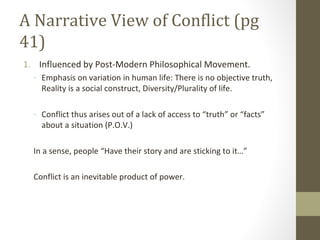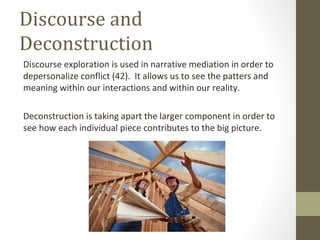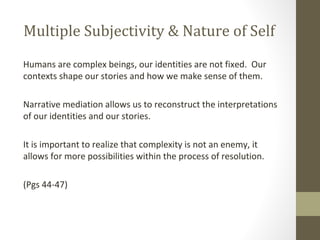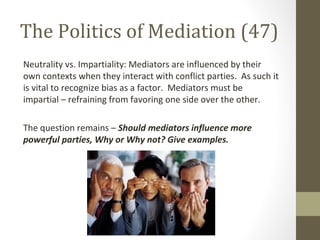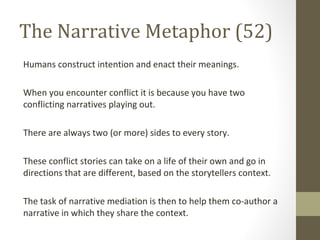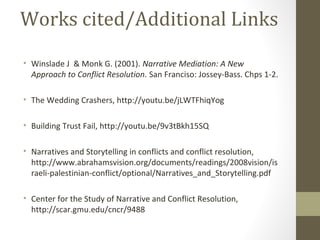Winslade_MonkWeek2
- 1. Narrative Mediation A New Approach to Conflict Resolution, Winslade & Monk Chapters 1-2 This section presented by: Sarah Hanisko
- 2. What is Narrative Mediation? Narrative mediation depends on the stories that parties in conflict use in the construction of their point of view. According to Winslade and Monk the “emphasis is on how the story operates to create reality rather than on whether it reports accurately on that reality.” pg 3.
- 3. Tightly Woven Stories… Since conflict parties tell their own stories, they are often bound up with bias, judgment and accusation. It is the narrative mediator’s job to open up the space in their “tightly woven” stories by destabilizing the descriptions in order to undermine the negative components of the conflict…this is accomplished through the creation of CONTEXT.
- 4. Building Context 1. Build Trust in the Mediator and Mediation Process (pg. 6.) - Respectful Listening - Taking stories seriously - Avoiding assumptions The following video is an example of how you should not build trust.
- 5. Externalize Conversations Externalizing conversations allow the mediator and conflict parties to reconstruct the conflict in less accusatory terms. (pg. 9) For example….. Instead of saying “your divorce” say “the divorce.” Instead of saying “your conflict” say “this conflict.” This process can help to remove blame and defensiveness from the situation.
- 6. Map the Conflict History
- 7. Construct Solution Bound Narratives Co-Author a story, based on previous accounts of the parties working together. This deconstructs negative perceptions and also allows the visualization of cultural messages that may be affecting the conflict, this is deconstructing dominant discourses. When you can successfully co-author a solution you can begin to build on previous positive experiences. While the two mediators in the below clip attempt to create a solution bound narrative….they don’t do a great job. What would you do differently? http://youtu.be/jLWTFhiqYog
- 8. Deconstruct Conversations By uncovering the context, cultural influences and “emerging discourses” of a conflict we can create new discourses for the parties that encourages moving toward consensus. The role of the narrative mediator is to guide the conflict parties in helping them to develop and elaborate on a new story for the future.
- 9. Theoretical & Philosophical Issues in Narrative Mediation – Chap 2
- 10. Social Construction (Burr) 1. Anti – Essentialism 2. Anti – Realism 3. Language as Pre-condition for thought 4. Language as a form of social action
- 11. A Narrative View of Conflict (pg 41) 1. Influenced by Post-Modern Philosophical Movement. - Emphasis on variation in human life: There is no objective truth, Reality is a social construct, Diversity/Plurality of life. - Conflict thus arises out of a lack of access to “truth” or “facts” about a situation (P.O.V.) In a sense, people “Have their story and are sticking to it…” Conflict is an inevitable product of power.
- 12. Discourse and Deconstruction Discourse exploration is used in narrative mediation in order to depersonalize conflict (42). It allows us to see the patters and meaning within our interactions and within our reality. Deconstruction is taking apart the larger component in order to see how each individual piece contributes to the big picture.
- 13. Multiple Subjectivity & Nature of Self Humans are complex beings, our identities are not fixed. Our contexts shape our stories and how we make sense of them. Narrative mediation allows us to reconstruct the interpretations of our identities and our stories. It is important to realize that complexity is not an enemy, it allows for more possibilities within the process of resolution. (Pgs 44-47)
- 14. The Politics of Mediation (47) Neutrality vs. Impartiality: Mediators are influenced by their own contexts when they interact with conflict parties. As such it is vital to recognize bias as a factor. Mediators must be impartial – refraining from favoring one side over the other. The question remains – Should mediators influence more powerful parties, Why or Why not? Give examples.
- 15. The Narrative Metaphor (52) Humans construct intention and enact their meanings. When you encounter conflict it is because you have two conflicting narratives playing out. There are always two (or more) sides to every story. These conflict stories can take on a life of their own and go in directions that are different, based on the storytellers context. The task of narrative mediation is then to help them co-author a narrative in which they share the context.
- 16. Questions & Activity How do narrative mediators view conflict? Should mediators influence more powerful parties, Why or Why not? Give examples. What would you say is the most powerful technique or approach in narrative mediation? Pick a television show that you enjoy in which there has been a significant conflict between at least two characters. Create a narrative of the conflict for each character, 1-2 pages.
- 17. Works cited/Additional Links • Winslade J & Monk G. (2001). Narrative Mediation: A New Approach to Conflict Resolution. San Franciso: Jossey-Bass. Chps 1-2. • The Wedding Crashers, http://youtu.be/jLWTFhiqYog • Building Trust Fail, http://youtu.be/9v3tBkh15SQ • Narratives and Storytelling in conflicts and conflict resolution, http://www.abrahamsvision.org/documents/readings/2008vision/is raeli-palestinian-conflict/optional/Narratives_and_Storytelling.pdf • Center for the Study of Narrative and Conflict Resolution, http://scar.gmu.edu/cncr/9488
Editor's Notes
- #3: Human’s are storytellers, we use our stories to make sense of our lives and our relationships.

